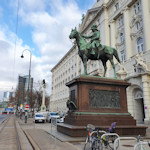
The Habsburgs never had the military kudos of the French or Prussians, for example. But one or two military leaders made a name for themselves. The Radetzky monument pays tribute to perhaps the most famous of all.
- Unveiled in 1892 in honour of the Field Marshal
- Moved to its current location in 1912
- Sculptor von Zumbusch also designed the Beethoven monument
- Book a themed guided tour* of Vienna
- See also:
One man and his horse

(Radetzky in Field Marshal pose)
When Austria’s national football team plays its home matches in Vienna, the fans collectively swing their flags in time to the Radetzky March. The same music rings out at the end of the famous New Year’s Concert by the Wiener Philharmoniker.
Johann Strauss I’s music is one of those pieces most of us instantly recognise from the opening bars, and he dedicated the 1848 work to Field Marshal Joseph Radetzky von Radetz (1766-1858).
Radetzky was one of the more successful military commanders under the Habsburgs, most notably in Italian campaigns in the late 1840s, and certainly the most renowned in the era of the Austrian Empire. So much so that he even gets his own section in the Heeresgeschichtliches military museum.
History may be a more discerning judge of his legacy, but imperial Vienna paid him various tributes. One is the Radetzky monument found on the west edge of the old town.

(The Radetzky monument at its original location on Am Hof around 1909; Wolf, Vereinigte Kunstanstalten Wien (Producer); Wien Museum Inv.-Nr. 65861/201; excerpt reproduced with permission under the terms of the CC0 licence)
The monument first appeared on Am Hof square in front of the war ministry on April 24th, 1892.
Radetzky then moved with the ministry in 1912 to stand guard over its new premises on Stubenring. That building now houses various government offices.
The move posed quite a challenge, thanks to the height of the statue. They had to partially dismantle the overhead electrical cables on Stubenring in the dead of night when no trams were running.
The original unveiling proved quite an event, too, with the surrounding buildings covered in flags and other decorations and the square full of soldiers and veterans.
Emperor Franz Joseph himself turned up, despite it being his wedding anniversary. Which might have led to some tension over breakfast.
No prizes for guessing what one of the pieces of music played at the event was (see above).

(A relief on the statue’s plinth)
Caspar von Zumbusch designed the 6,000 kg bronze figure of Radetzky and his horse. Three of the sculptor’s other notable works include Vienna’s Beethoven monument, the Archduke Albrecht monument, and the Maria Theresa monument.
The Emperor allegedly told Zumbusch (my translation):
“Your artistic intentions match the character of the old marshal completely”
One relief on the plinth shows Radetzky at a council of war with various generals. The other has the Field Marshal enjoying the acclaim of a diverse group of soldiers (see photo above).
The plaque at the front quotes a line in an 1848 poem dedicated to Radetzky by Franz Grillparzer, who has his own monument over in the Volksgarten park.
The German translates to:
Austria is in your camp
Once at Radetzky, take a peek at the building opposite. Many consider the famous Postsparkasse designed by Otto Wagner a milestone in the development of modern architecture. The ministry building behind the Field Marshal went up around the same time: quite a contrast in style!
Afterwards, walk clockwise around the Ring boulevard to find the MAK applied arts museum and anti-clockwise to see the Urania building (another turn-of-the-century classic).
How to get to Radetzky
Subway: a short walk from Stubentor station on the U3 line or Schwedenplatz on the U1 and U4 lines.
Tram/bus: both the 1 and 2 tram lines stop at Julius-Raab-Platz, which is just a skip and a jump from the statue.
Address: Stubenring 1, 1010 Vienna